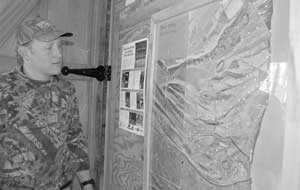
Wild quail still to be had in La.
Dear Capt. Paul:
I purchased a handheld Garmin GPS III quite a few years back.
I was hoping to use the unit for deer hunting. I had plans for pinpointing stand locations in particular.Thus far I have been extremely disappointed with its accuracy. The unit takes too long to change the direction arrow. In some cases, I may have to walk 50+ yards before the direction changes.
Do you know of any way to improve the accuracy? I have read the manual numerous times, and can’t seem to improve it.
Would any of the newer units equipped with WAAS accomplish what I want?
Thanks,
Ryan
Capt. Paul’s response:
The Garmin GPS III is a decent GPS receiver. It was the state-of-the-art when first introduced. It does not have the ability to receive WAAS signals, and as such delivers a position accuracy of 15 meters (about 48 feet).
There are several things that you should check in order to assure that you are getting the best info that the unit has to offer.
First check the Garmin web site (www.garmin.com) for the latest operating software available for the unit. The present standard is version 2.10 issued on Jan. 31, 2000. If your unit does not have that version of Gamin’s software, you can download it from their web site (www.garmin.com/support/blosp.jsp) and install it in your unit.
The newer releases usually are issued to correct some problems encountered in earlier software versions. The newer versions sometimes speed up the position updates and allow additional waypoints to be stored in the unit.
By the way, concerning storing waypoints and other data in the unit, the GPS III uses an internal lithium battery to “keep” the memory in the unit. If this internal battery fails, all of your waypoints, tracks and routes will be permanently gone.
The battery usually has an 8 year life, but it can only be serviced by Garmin. Keeping this in mind, be sure to back up your data.
The second thing you can check is the operating mode of the unit. Some software versions allow you to select and use a battery saver mode of operation. While the battery-saver mode may allow you to operate the unit for a longer period of time, it also delays the update frequency that the unit displays.
This means that you may have moved to several different positions before the new position is updated on the GPS screen. It describes your update frequency problem.
Third, be sure that the unit’s antenna has a clear of view of the sky. I carry my GPS unit in an “off gun shoulder” pocket that my wife made on my hunting vest. This high position allows the unit to receive the signals while I am walking in the woods. I attach the GPS to my vest via a boot lace to keep from losing the unit in the event that I bend over.
And the answer is yes to your last question. My Garmin GPS 60C with WAAS active usually provides me with an accuracy of under 10 feet in a lightly tree canopied setting, as found in the fall and winter, and about a 20-foot accuracy in the spring and summer. The trees, you see, absorb the satellite signals more when there are more leaves on the branches.
In addition, the unit can store the latest Garmin MapSource TOPO US mapping software. So I have a detailed topo map of my area with one of the fastest, more accurate units on the market today.
I carry the unit in its fastest updating mode near my shoulder, with a spare set of batteries in my “possibles” bag. Using the GPS, I’ve now given up on flagging tape, and now only occasionally use Bright Eyes to keep me out of trouble.
I hope that my response is of some help to you.
Got GPS question for Capt. Paul? Post it at www.lasmag.com, and you may be featured in a coming issue.


